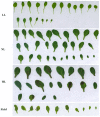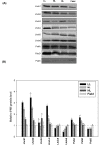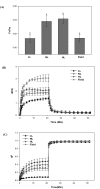Arabidopsis plants grown in the field and climate chambers significantly differ in leaf morphology and photosystem components
- PMID: 22236032
- PMCID: PMC3296669
- DOI: 10.1186/1471-2229-12-6
Arabidopsis plants grown in the field and climate chambers significantly differ in leaf morphology and photosystem components
Abstract
Background: Plants exhibit phenotypic plasticity and respond to differences in environmental conditions by acclimation. We have systematically compared leaves of Arabidopsis thaliana plants grown in the field and under controlled low, normal and high light conditions in the laboratory to determine their most prominent phenotypic differences.
Results: Compared to plants grown under field conditions, the "indoor plants" had larger leaves, modified leaf shapes and longer petioles. Their pigment composition also significantly differed; indoor plants had reduced levels of xanthophyll pigments. In addition, Lhcb1 and Lhcb2 levels were up to three times higher in the indoor plants, but differences in the PSI antenna were much smaller, with only the low-abundance Lhca5 protein showing altered levels. Both isoforms of early-light-induced protein (ELIP) were absent in the indoor plants, and they had less non-photochemical quenching (NPQ). The field-grown plants had a high capacity to perform state transitions. Plants lacking ELIPs did not have reduced growth or seed set rates, but their mortality rates were sometimes higher. NPQ levels between natural accessions grown under different conditions were not correlated.
Conclusion: Our results indicate that comparative analysis of field-grown plants with those grown under artificial conditions is important for a full understanding of plant plasticity and adaptation.
© 2011 Mishra et al; licensee BioMed Central Ltd.
Figures










Similar articles
-
Xanthophyll biosynthetic mutants of Arabidopsis thaliana: altered nonphotochemical quenching of chlorophyll fluorescence is due to changes in Photosystem II antenna size and stability.Biochim Biophys Acta. 2002 Feb 15;1553(3):309-19. doi: 10.1016/s0005-2728(02)00184-6. Biochim Biophys Acta. 2002. PMID: 11997140
-
Acclimation- and mutation-induced enhancement of PsbS levels affects the kinetics of non-photochemical quenching in Arabidopsis thaliana.Planta. 2011 Jun;233(6):1253-64. doi: 10.1007/s00425-011-1380-5. Epub 2011 Feb 22. Planta. 2011. PMID: 21340700
-
Photosynthesis, chlorophyll fluorescence, light-harvesting system and photoinhibition resistance of a zeaxanthin-accumulating mutant of Arabidopsis thaliana.J Photochem Photobiol B. 1996 Jun;34(1):87-94. doi: 10.1016/1011-1344(95)07272-1. J Photochem Photobiol B. 1996. PMID: 8765663
-
Plants impaired in state transitions can to a large degree compensate for their defect.Plant Cell Physiol. 2003 Jan;44(1):44-54. doi: 10.1093/pcp/pcg012. Plant Cell Physiol. 2003. PMID: 12552146
-
Translational photobiology: towards dynamic lighting in indoor horticulture.Trends Plant Sci. 2025 Mar;30(3):301-310. doi: 10.1016/j.tplants.2024.10.006. Epub 2024 Oct 30. Trends Plant Sci. 2025. PMID: 39482192 Review.
Cited by
-
Cutting the Gordian Knot of abiotic stress in grapevine: From the test tube to climate change adaptation.Physiol Plant. 2019 Feb;165(2):330-342. doi: 10.1111/ppl.12857. Epub 2018 Dec 21. Physiol Plant. 2019. PMID: 30357847 Free PMC article. Review.
-
Cold stress and freezing tolerance negatively affect the fitness of Arabidopsis thaliana accessions under field and controlled conditions.Planta. 2022 Jan 15;255(2):39. doi: 10.1007/s00425-021-03809-8. Planta. 2022. PMID: 35032192 Free PMC article.
-
Remarkable Evolutionary Conservation of Antiobesity ADIPOSE/WDTC1 Homologs in Animals and Plants.Genetics. 2017 Sep;207(1):153-162. doi: 10.1534/genetics.116.198382. Epub 2017 Jun 29. Genetics. 2017. PMID: 28663238 Free PMC article.
-
Cross-talk between high light stress and plant defence to the two-spotted spider mite in Arabidopsis thaliana.Exp Appl Acarol. 2017 Oct;73(2):177-189. doi: 10.1007/s10493-017-0187-x. Epub 2017 Nov 8. Exp Appl Acarol. 2017. PMID: 29119280
-
The zeaxanthin epoxidase is degraded along with the D1 protein during photoinhibition of photosystem II.Plant Direct. 2019 Dec 1;3(11):e00185. doi: 10.1002/pld3.185. eCollection 2019 Nov. Plant Direct. 2019. PMID: 31819921 Free PMC article.
References
-
- Atkin OK, Loveys BR, Atkinson LJ, Pons TL. Phenotypic plasticity and growth temperature: understanding site-specific variability. J Exp Bot. 2006;57:267–281. - PubMed
-
- Poorter H, Pepin S, Rijkers T, de Jong Y, Evans JR, Körner C. Construction costs, chemical composition and payback time of high- and low-irradiance leaves. J Exp Bot. 2006;57:355–371. - PubMed
Publication types
MeSH terms
Substances
LinkOut - more resources
Full Text Sources
Other Literature Sources
Molecular Biology Databases

